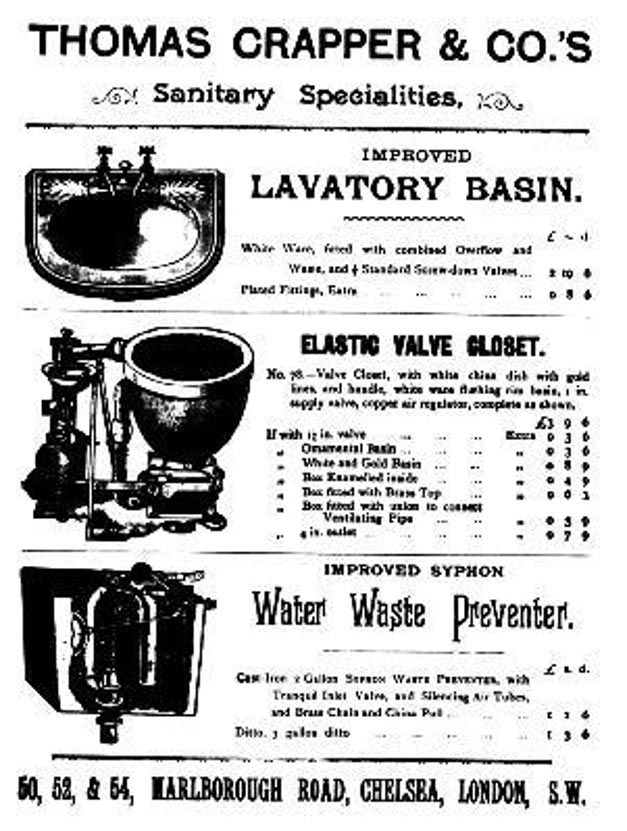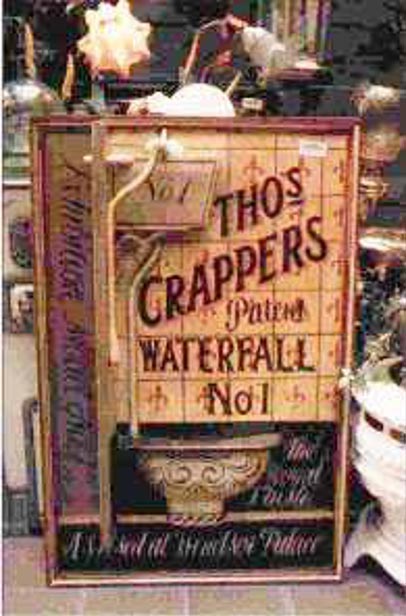Word Count: 733
Est. Time to Read: 5 mins.
Thomas Crapper was his name. Entrepreneurism, invention, and plumbing were his games.
Thank you, thank you, thank you, Tommy!
Crapper, a real man and a real plumber/businessman, did not REALLY invent the flushable toilet, as most people ascribe to him. The original flushable toilet was “described” in 1596 by Sir John Harington, godson of Queen Elizabeth I. Sir John envisioned a two-foot deep oval bowl waterproofed with pitch, resin and wax, and fed by water from an upstairs cistern. However, this system required a virtual torrent of 7.5 gallons of water per “flush”, making it nearly impossible to use regularly. Yet, Sir John assured the Queen and others that during water scarcity the “pot” would allow 20 people to use the device between “flushes” (NOTE: I can easily see why the device was only installed in one of the Queen’s residences).
In 1775 Alexander Cumming, an English inventor, was granted the first patent for a flush toilet, improving on the original designs by adding the S-Shaped pipe below the bowl which created a seal preventing sewer gases from entering the toilet. THANK YOU, Alexander Cumming!

Finally, Thomas Crapper, our hero, enters the picture, and, though he did not “invent” the flushable toilet, he improved it greatly and made it more feasible (NOTE: Entrepreneurs don’t always have to “invent” something; sometimes they add value by improving things). Just what was his contribution that led to wide-spread manufacturing and use of this blessed device? He developed the “ballcock”, an improved tank-filling device still in use today, thereby conserving water per “flush”.
So, why is “crap”, “crapper”, etc. still a vital part of some people’s colorful and descriptive language today? The word “crap” predated Thomas by centuries and was commonly used in England, but the name Crapper was associated with Thomas’s manufactured device. The unfamiliarity of the term to American “Doughboys”, during WWI, invited them to go the easy route and simply call the English and French devices “Crappers”. The American soldiers, full of adventurous spirit, confiscated the term and brought it into common use in the states, where it was easily and eagerly adopted.
So, why even mention this bit of arcane and sometimes unspeakable trivia? Well, despite Thomas Crapper being an entrepreneur and a plumber/tradesman, he was also a businessman, who operated three plumbing shops (which he sold to his two partners, who continued the business under the Crapper name until 1966) and held NINE patents. Four patents protected his improvements to drains, three for water closet designs, one for pipe joints and one for manhole covers.
Obviously, he was quite a guy. Although researching Thomas Crapper, (Not “Sir”, as he was never knighted) results in some controversy about the actual invention of the crapper/loo/water closet, commode, john, etc., Crapper is clearly associated with the refinement and popularization of the device by the U.S. WWI servicemen.
Look for yourself and learn more of the legend of the “king of flushers”. You may find some interesting facts and folklore.
AND, why write this now? Well, January 27th was the anniversary of Thomas Crapper’s death in 1910. We are several weeks late celebrating Crapper’s Day, as the Brits called it for a while. Sorry for the late notice. Put it on your calendar for next year. We certainly will.

Side notes:
- The Reverend Henry Moule invented the first “eco-loo” in England in 1860. Called the Earth Closet, it used dry earth to “flush”, not water, and was a success for decades.
- The first commercially available toilet paper was introduced in New York in 1857 by Gayety’s Medicated Paper Company.
- Moving away from toilet squares in boxes, the Scott Paper Company of Philadelphia first introduced rolls of lavatory paper in 1879.
- In 1935, one manufacturer of toilet paper in Britain advertised their paper as “splinter free” – again, a big round of applause for this company!
- Finally, some industrious soul who studies this type of stuff, determined that IF all the rolls of “loo paper” used in 12 months in Great Britain were laid end-to-end, the strip of paper would extend beyond Mars. However, the bad news is that Americans use TWICE the amount of toilet paper, per person, compared to the Brits!
Happy Trips to the Reading Room – where some of my research begins with reading issues of “Uncle John’s Bathroom Reader”.